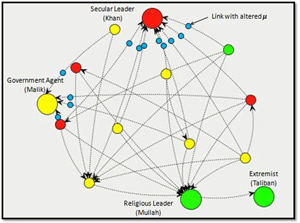
Social network structure plays a large role in leadership selection
Pashtuns are the largest tribal group in Afghanistan. In traditional Pashtun society, leadership is manifested as an informal power system where potential leaders gain and maintain their position by means of group consensus. Leadership power is spread over three areas of influence resulting in a triad of leadership roles. These leaders compete, vying for power and control based on public opinion. The addition of extremists into this system (who utilize threats of harm to gain power) disrupts the traditional system, altering the balance of power.
Opinion dynamics models capture the propagation of an opinion value across a social network. As individuals interact, their opinions change depending on how different those opinions are. This presents a suitable paradigm to examine the flow of opinions concerning potential leaders within a Pashtun community and the effects of changes in these opinions on the leadership balance of power.

Kahn, Government Agent: Malik, Religious Leader: Mullah) and tribal members as nodes and their social connections as links between these nodes. This conceptual model is instantiated as a bounded confidence opinion dynamics computational model.
Report
Modeling Tribal Leadership Dynamics: An Opinion Dynamics Model of Pashtun Leadership Selection, Sandia National Laboratories report, October 2011 [PDF]